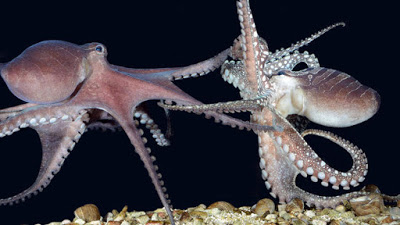Nature is full of wonders and strange things that would blow our mind if we look closely enough. From the mind-bending events taking place in space, to the amazing things animals and plants do on our own planet. The animal kingdom is full of all kinds of weird wonders and fantastical activities. Which is to be expected if we have a sample size of millions of species in a chaotic world driven by almost unpredictable evolution, adaption, and natural selection.
The mating ritual of octopi is one such thing we would have a hard time believing, let alone understanding. There are estimated to be around 300 species of octopi, or octopuses. Many of them are highly intelligent as well, capable of solving mazes and imitation. They have a lifespan of from three to five years. Except some variations, the mating of all the species is almost alike. As you know, octopi have eight long arms. These aquatic creatures can squeeze through tight spaces due to a lack of bones. And it is one of these arms that plays a significant role in the mating, at least in the cases of male octopi.

You can say that the mating of octopi is a subdued and mechanical affair. When the female octopus is ready to mate, she releases the equivalent of pheromones which attract males. The male octopus has a special arm called hectocotylus in which spermatophores, or packets of sperm, are stored. In most species, it is the third arm. The male transfers the sperm packets using hectocotylus to the mantle of the female. In some species, the male detaches its entire arm and would give it to the female.
The female stores the sperm (or the arm) until she is ready to lay eggs. At the time of laying eggs, she would spread the sperm over them and fertilize them. The number of eggs vary from species to species, and can go up to 200,000. The eggs take between two to ten months to hatch, and the female cares for them well, even avoiding food. She sometimes blows water on the eggs to keep them clean and to ensure a supply of oxygen. Upon hatching, the newborns are on their own and feed on small planktonic creatures. Only a tiny fraction of them would survive the predators and make it to the adult stage, to start another cycle of reproduction.
The octopuses don’t survive the mating for too long. The male dies soon after the mating while the female dies after the hatching of her eggs. Scientists have recently discovered that the females of some species suffocate the males to death immediately after the mating, for reasons unknown. More research is going into this phenomenon.
That is all of course, if the mating actually progresses. In many instances, when a male approaches a female octopus, he is killed and devoured by her instead. This is because female octopi are generally larger, stronger, and hungrier than their male counterparts. Male octopi have in fact been observed sneaking close to a female octopus pretending to be another female to avoid becoming her dinner. The arm detachment process mentioned above seems to be one of the tricks a male can use to try to survive the mating process.
Octopi mating works very much against how they have otherwise evolved. Octopi, unlike their other cephalopod cousins, tend to be very antisocial and often partake in cannibalism. Their mating process however, is much more intimate than other cephalopod species. Why they evolved to mate like this is anyone’s guess. Fortunately for their species, the number of eggs laid easily replaces the losses taken during copulation.
